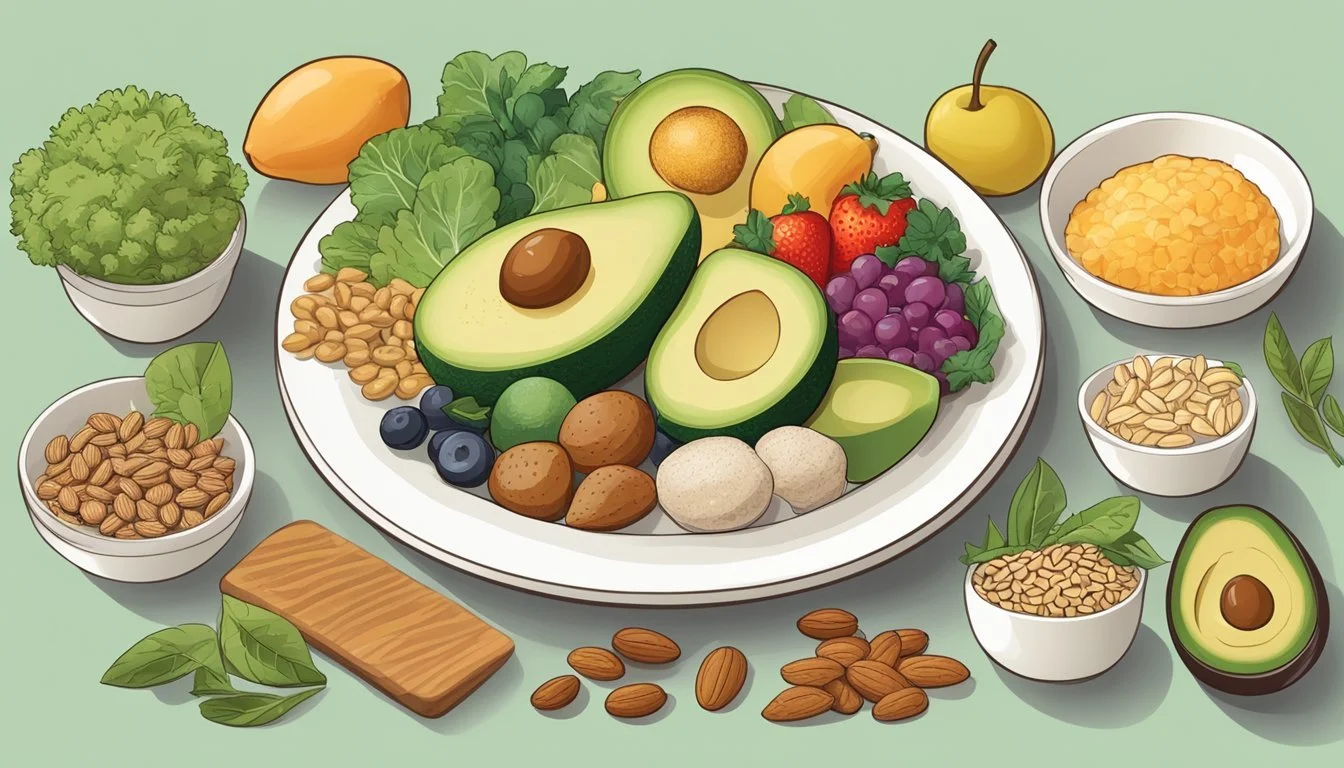Should You Avoid Eating Fat to Lose Weight?
Unpacking Dietary Myths
The topic of dietary fat's role in weight loss is complex and often misunderstood. Traditional dieting advice has long emphasized the reduction of fat intake based on the assumption that fat is more calorie-dense than carbohydrates or protein. While it is true that fat contains 9 calories per gram compared to 4 calories per gram for the other two macronutrients, recent research suggests that fat plays a crucial role in satiety and overall health. It's important to distinguish between different types of fats, as some can support weight loss efforts when consumed in moderation. Unsaturated fats, such as those found in avocados, nuts, seeds, and olive oil, have been identified as part of a heart-healthy diet.
The key in considering fat consumption for weight loss is to focus on balance and the quality of the fats being ingested. Eliminating fat entirely from the diet is not necessary and can be detrimental, as fats are essential for nutrient absorption and cellular health. Instead, it is critical to reduce the intake of trans fats and limit saturated fats, which are commonly found in processed foods and red meats. These types of fats are more likely to contribute to weight gain and increase the risk of heart disease when consumed in excess.
Understanding that not all fats are created equal is essential for maintaining a healthy diet and achieving weight loss goals. Incorporating healthy fats in moderation while steering clear of unhealthy ones is a sustainable approach. The emphasis should be on overall dietary patterns and lifestyle choices that promote health, rather than simply reducing fat to lose weight.
Understanding Fats in Diet
Fats play a crucial role in nutrition and overall health, influencing everything from cellular structure to heart disease. This section explores the various types of fats, their roles and effects on the body, and tackles some common misconceptions.
Types of Fat
Fats are broadly categorized into three types based on their chemical structure: saturated fat, unsaturated fat, and trans fat.
Saturated fats: Typically solid at room temperature, they are found in animal products and some plant oils. High intake of saturated fats is linked to higher cholesterol levels.
Unsaturated fats: These are usually liquid at room temperature and are split into two categories: monounsaturated and polyunsaturated fats. They are considered beneficial fats that can improve heart health.
Trans fats: Mostly formed through industrial processes that add hydrogen to vegetable oil, they are associated with an increased risk of heart disease.
Roles and Effects of Fats
Fats are essential for various bodily functions:
Cell structure: They are key components of cell membranes.
Vitamin absorption: Certain vitamins require fat for absorption and transportation.
Energy: Fats are a dense source of energy, providing 9 calories per gram.
Hormone production and regulation: Many hormones are synthesized from fats.
The effects of fats on health are significant:
Heart health: Unsaturated fats can lower the risk of heart disease, whereas saturated and trans fats may increase this risk due to their impact on cholesterol levels.
Obesity: Although fats are high in calories, they can contribute to satiety, potentially helping with weight management when consumed in moderation.
Misconceptions About Fats
Contrary to common belief, fats are not universally harmful and should not be eliminated from the diet. Instead, they should be consumed thoughtfully:
Not all fats are equal: Unsaturated fats are healthier choices over saturated and trans fats.
Balance is key: Dietary guidelines suggest a balanced intake of fats, with a focus on minimizing trans and saturated fats, within a nutritionally diverse diet.
Incorporating healthy fats while being mindful of portion sizes and total caloric intake is crucial for maintaining a balanced diet and supporting overall health.
Fat Consumption and Weight Management
When it comes to weight management, understanding the role of dietary fat is crucial. The amount and type of fat consumed can influence calorie intake, weight control, and overall health.
Fat Intake and Obesity
A high intake of dietary fats is often associated with an increase in calorie consumption, as fats are more calorie-dense than carbohydrates or proteins. Specifically, one gram of fat contains approximately 9 calories, compared to just 4 calories for the same amount of carbohydrates or proteins. Consuming fat in excess can lead to an increase in body weight if it causes total calorie intake to surpass what the body utilizes for energy.
Balancing Calorie Intake and Fat
Effective weight management involves balancing calories consumed with calories expended through physical activity and metabolic processes. To avoid weight gain, an individual should not consume more calories than they burn. For example, on a 2,000 calorie diet, up to 30% could theoretically come from fat, which equates to about 66.7 grams of fat per day. Monitoring portion sizes and choosing foods with healthy fat content can help maintain this balance.
Healthy Fats and Weight Loss
Incorporating healthy fats into a diet can be beneficial for weight loss. Unsaturated fats, found in foods like avocados, nuts, seeds, and olive oil, not only contribute to feeling full but also support heart health. Such fats should be consumed instead of trans fats and saturated fats, which are linked to negative health outcomes. Utilizing healthy fats in moderation as part of a balanced diet can aid in losing weight and maintaining weight loss.
Dietary Fat and Nutrition
Dietary fats play a crucial role in nutrition by supporting cell growth, protecting organs, and aiding in the absorption of key vitamins. While they should be consumed in moderation, certain types of fats are beneficial to a healthy diet.
Sources of Healthy Fats
Unsaturated fats are considered heart-healthy and can be found in:
Olive oil: A monounsaturated fat, known for its role in the Mediterranean diet.
Nuts: Such as almonds and walnuts, provide both monounsaturated and polyunsaturated fats.
Seeds: Including chia seeds and flaxseeds, which contain omega-3 fatty acids.
Fish: Fatty fish like salmon and mackerel are rich sources of omega-3 fatty acids.
Avocado: High in monounsaturated fats and also offers fiber and various essential nutrients.
Incorporating Fats into a Balanced Diet
A balanced diet includes a mix of carbohydrates, proteins, and fats. Healthy fats can be incorporated by:
Choosing snacks like a handful of nuts or avocado on toast.
Preparing fish as a primary protein source twice a week.
Using olive oil in dressings and for cooking instead of saturated fats.
Fat-Soluble Vitamins and Nutrient Absorption
Fats assist in the absorption of fat-soluble vitamins—vitamins A, D, E, and K. Adequate intake of healthy fats is vital for:
Nutrient absorption: Fat-free diets can lead to deficiencies in these vitamins.
Nutrition: Ensuring meals contain some fats can aid in the overall nutritional quality of the diet.
When planning meals, consider both the type of fat and how it complements the other macronutrients to contribute to a well-rounded nutritional profile.
Analyzing Labels and Fat Content
When attempting to lose weight, one should pay close attention to food labels, specifically the fat content, which includes total fat, serving sizes, and portions. It's crucial to distinguish between types of fats and understand their implications for weight loss goals.
Deciphering Nutritional Labels
A nutritional label provides detailed information about the fat content in foods. One should look for total fat, which is divided into saturated, trans, monounsaturated, and polyunsaturated fats. As per dietary guidelines, individuals are advised to limit saturated fat to less than 10% of calories per day. Importantly, trans fats should be avoided completely due to their negative impact on heart health.
Total Fat: Indicated in grams and often broken down into different types. For weight loss, it is recommended to monitor and regulate intake.
Added Sugars: Typically listed under the "Total Carbohydrates" section, these should be limited as they add extra calories and can contribute to weight gain.
Calories: Essential to note since weight loss requires a calorie deficit. The label indicates the number of calories per serving.
Understanding Serving Sizes and Portions
The serving size on a nutritional label is a standardized amount used to help consumers quantify how much of a food is typically eaten at one time, which allows for a clearer understanding of calorie and nutrient intake.
Portion size, on the other hand, is the actual amount one chooses to eat, which may not align with the serving size indicated on the label. Keeping portion sizes in check is fundamental in managing caloric intake for weight loss.
Serving Size: Usually found at the top of the nutrition label. It's vital to compare this with the portion you are actually consuming.
Label Information Amount Serving Size 1 cup (228g) Servings Per Container 2
Portion Size: For accurate tracking of fat and calorie intake, one must adjust the information on the label based on the portion size consumed.
Consumed Adjustment Needed 1/2 cup (114g) Divide totals on label by 2
Foods to Moderate for Better Health
In pursuit of better health and weight management, particular attention should be paid to the quality and types of foods consumed.
Limiting Saturated and Trans Fats
Individuals should limit their intake of saturated fats, which are primarily found in animal-based products such as meat and dairy. These fats can raise cholesterol levels and increase the risk of heart disease. Foods high in trans fats—such as certain baked goods and fried foods (What wine goes well with fried foods?)—should also be consumed sparingly, as they can contribute to heart disease and inflammation.
Reducing Intake of Processed Foods
Processed foods often contain high levels of sugar, salt, and unhealthy fats. Reducing their consumption can decrease the risk of obesity, diabetes, and cardiovascular diseases. Notably, these foods might also have lower nutritional value compared to whole, unprocessed counterparts.
Beverages and Weight Gain
Beverages like soda and fruit drinks can have significant amounts of sugar and calories with little to no nutritional benefit. They can contribute to weight gain and may not provide the same feeling of fullness that solid foods do. Moderating the intake of alcohol is also advised, as it has calorie content and can interfere with metabolism and appetite regulation.
Lifestyle Factors Influencing Weight and Health
In the journey towards weight management and improved health, lifestyle factors such as exercise and stress-related behaviors play crucial roles. They directly influence an individual's ability to maintain or achieve a healthy weight and overall health, including heart health.
The Role of Exercise in Weight Management
Regular physical activity is a cornerstone for maintaining a healthy weight. Exercise helps in burning calories and building muscle, which can increase the body's metabolic rate, even at rest. For effective weight management, the Centers for Disease Control and Prevention (CDC) recommends:
Aerobic activity: At least 150 minutes a week of moderate-intensity, or 75 minutes a week of high-intensity exercise.
Muscle-strengthening activities: At least two days a week.
These can not only prevent weight gain but also support weight loss when coupled with a healthy diet. Exercise is also beneficial for heart health as it helps in reducing blood pressure and improving cholesterol levels.
Stress, Sleep, and Weight
Stress and sleep are often overlooked when considering weight management. Chronic stress can trigger the body's release of cortisol, which may lead to weight gain or difficulty losing weight. Effective stress management techniques include:
Mindfulness meditation
Adequate social support
Regular physical activity
Sleep also plays a vital role. A lack of sleep can disrupt hormonal balances, leading to increased appetite and cravings for high-calorie foods. Adults should aim for:
7-9 hours of sleep per night for optimal health
A consistent sleep schedule and good sleep hygiene can contribute to better stress management, weight control, and overall health.
Conclusion
Eating fat is part of a balanced diet and should not be entirely avoided when trying to lose weight. Unsaturated fats, found in avocados, nuts, seeds, and olive oil, are essential for a healthy lifestyle and long-term health. They contribute to satiety and provide necessary nutrients.
While it's important to monitor intake for weight management, moderation is key rather than complete elimination. Saturated fats, particularly from processed meats, should be limited, but not because they are the sole factor in heart disease. Low-fat foods can sometimes contain high amounts of sodium, sugar, or processed carbohydrates, which could be counterproductive.
A varied diet that includes both carbohydrate and fat control can lead to weight loss, but individual diet plans should consider personal health conditions and dietary needs. It's advisable to choose a diet that can be maintained consistently.
One should focus on:
Variety: Incorporating different foods into meals to get a range of nutrients.
Balance: Eating the right amounts of foods from all food groups.
Moderation: Not eating too much of any one type of food, especially those high in calories and low in nutrients.
Maintaining a balanced diet with healthy fats and a calorie intake that supports weight management can foster both weight loss and overall health without the need to avoid dietary fats entirely.






